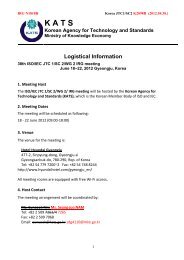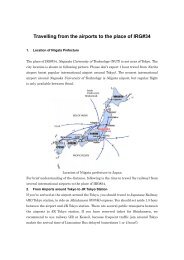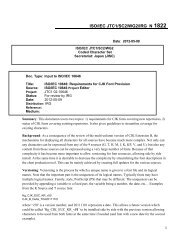Create successful ePaper yourself
Turn your PDF publications into a flip-book with our unique Google optimized e-Paper software.
®<br />
The Design & Development of<br />
<strong>Pan</strong>-<strong>CJK</strong> <strong>Font</strong>s<br />
Dr. Ken Lunde<br />
Senior Computer Scientist<br />
Adobe Systems Incorporated<br />
lunde@adobe.com<br />
®<br />
© 2010 Adobe Systems Incorporated. All rights reserved. 1
®<br />
<strong>What</strong> <strong>Is</strong> A <strong>Pan</strong>-<strong>CJK</strong> <strong>Font</strong><br />
A <strong>Pan</strong>-<strong>CJK</strong> font includes glyphs suitable for multiple <strong>CJK</strong> locales<br />
China, Taiwan, Hong Kong, Japan, and Korea are the five most important <strong>CJK</strong> locales<br />
“Han Unification” necessitates multiple glyphs for many <strong>CJK</strong> Unified Ideograph code points<br />
A <strong>Pan</strong>-<strong>CJK</strong> font is Unicode-based<br />
No other character set or encoding in common use today can claim adequate <strong>CJK</strong> support<br />
Unicode has become the preferred method for representing text in digital form<br />
A <strong>Pan</strong>-<strong>CJK</strong> font represents an incredible amount of work—time & effort<br />
How does a <strong>Pan</strong>-<strong>CJK</strong> font differ from a <strong>Pan</strong>-Chinese font<br />
There are three primary Chinese-speaking locales: China, Taiwan, and Hong Kong<br />
Some simplified/traditional distinctions have been unified<br />
Some distinctions have not been unified<br />
These distinctions are handled via separate code points<br />
A <strong>Pan</strong>-Chinese font can be treated as a first step toward developing a <strong>Pan</strong>-<strong>CJK</strong> font<br />
© 2010 Adobe Systems Incorporated. All rights reserved. 2
®<br />
<strong>Pan</strong>-<strong>CJK</strong> <strong>Font</strong> Origins & Goals<br />
Single-locale <strong>CJK</strong> fonts can be fully-functional with one glyph per code point<br />
This is easily demonstrated by today’s single-locale <strong>CJK</strong> fonts<br />
Some single-locale <strong>CJK</strong> fonts still require multiple glyphs for some code points<br />
For the purpose of supporting single-locale variant forms<br />
Multiple-locale <strong>CJK</strong> fonts require more than one glyph for some code points<br />
<strong>CJK</strong> Unified Ideograph code points are the obvious target and concern<br />
Punctuation and other characters may require locale-specific forms<br />
© 2010 Adobe Systems Incorporated. All rights reserved. 3
®<br />
<strong>Pan</strong>-<strong>CJK</strong> <strong>Font</strong> Advantages<br />
Typeface design consistency across multiple locales<br />
Weight<br />
Style<br />
Width<br />
Relative size<br />
Hinting, which influences rendering at smaller sizes and at lower resolutions<br />
Other design factors<br />
Smaller overall footprint<br />
A large number of glyphs are shared by two or more locales<br />
Subroutinization benefits<br />
Applies to OpenType/CFF fonts<br />
Single font file<br />
Streamlined testing<br />
© 2010 Adobe Systems Incorporated. All rights reserved. 4
®<br />
<strong>CJK</strong> Unified Ideographs: URO Versus Extensions<br />
Premise: <strong>CJK</strong> Unified Ideograph code points require multiple glyphs<br />
Some code points require only one glyph—many are single-source code points<br />
Some require more than one glyph—these are multiple-source code points<br />
Single- versus multiple-source code points<br />
Single-source code points generally require only one glyph<br />
Multiple-source code points have the potential to require more than one glyph<br />
Example: U+4E00 () has six sources, but clearly requires only one glyph<br />
URO (Unified Repertoire & Ordering)<br />
20,902 + 22 (Unicode 4.1) + 8 (Unicode 5.1) + 8 (Unicode 5.2) = 20,940 code points<br />
Extensions<br />
Extensions A (6,582), B (42,711), C (4,149), and D (222) exist<br />
The higher the Extension, the greater the percentage of single-source code points<br />
The higher the Extension, the lower the percentage of multiple-source code points<br />
© 2010 Adobe Systems Incorporated. All rights reserved. 5
®<br />
<strong>CJK</strong> Unified Ideographs: URO Versus Extensions (cont’d)<br />
(Number of Sources) 1 2 3 4 5 6 7<br />
URO (20,940) 9% 7% 11% 18% 32% 22% 1%<br />
Extension A (6,582) 9% 27% 41% 20% 3% >0% >0%<br />
Extension B (42,711) 45% 41% 14% 1% >0%<br />
Extension C (4,149) 91% 8% >0% >0%<br />
Extension D (222) 98% 2%<br />
© 2010 Adobe Systems Incorporated. All rights reserved. 6
®<br />
<strong>CJK</strong> Unified Ideographs: URO Versus Extensions (cont’d)<br />
Significantly more “work” is required for URO code points<br />
The URO has a high percentage of multiple-source code points<br />
Remember that multiple-source code points have the “potential” to require multiple glyphs<br />
Not all multiple-source code points require multiple glyphs<br />
The higher the Extension, the less “work” that is required<br />
Higher Extensions have a higher percentage of single-source code points<br />
Code-point/glyph-count ratios<br />
The URO and Extension A require roughly a 50% increase in glyphs over code points<br />
Approximately 30K glyphs are necessary to cover the 20,940 URO code points<br />
Approximately 10K glyphs are necessary to cover the 6,582 Extension A code points<br />
© 2010 Adobe Systems Incorporated. All rights reserved. 7
®<br />
Locale-specific Glyph <strong>Is</strong>sues<br />
Different glyphs for the same locale<br />
Multiple-column <strong>CJK</strong> Unified Ideograph code charts versus current source glyphs<br />
Some source glyphs have changed over time<br />
JIS X 0213:2004 (Japan) is a good example<br />
Handling <strong>CJK</strong> Unified Ideographs without sources for specific locales<br />
For those specific to a single locale, it is appropriate to ignore<br />
Simplified Chinese is a good example<br />
U+8BED () is tied to a single-locale, specifically Simplified Chinese<br />
For the remainder, it becomes a policy issue<br />
Extrapolate or ignore<br />
© 2010 Adobe Systems Incorporated. All rights reserved. 8
®<br />
Locale-specific Glyph <strong>Is</strong>sues—Specific Examples<br />
Source glyphs that changed over time: U+8FBB<br />
Original Japanese source glyph: (JIS X 0208-1990 36-52)<br />
Current Japanese source glyph: (JIS X 0213:2004 1-36-52)<br />
Multiple-source <strong>CJK</strong> Unified Ideographs that require only one glyph: U+4E00<br />
All sources: <br />
Two glyphs serve more than two code points: U+5668, U+FA38 & U+20F96<br />
U+5668 glyphs<br />
for Japan, and for all other sources<br />
U+FA38 glyph (ignoring that the distinction that is meant to be preserve cannot be preserved)<br />
for Japan<br />
U+20F96 glyph<br />
for Taiwan<br />
© 2010 Adobe Systems Incorporated. All rights reserved. 9
®<br />
<strong>Pan</strong>-<strong>CJK</strong> <strong>Font</strong> Implementation Details<br />
TrueType Collection—via separate font instances<br />
Pro: ‘locl’ GSUB feature support is not necessary; no need to choose a default locale<br />
Con: Multiple font instances in application font menus<br />
Can be considered a Pro in some uses or contexts<br />
OpenType—via ‘locl’ GSUB feature<br />
Pro: Single font instance in application font menus<br />
Can be considered a Con in some uses or contexts<br />
Con: ‘locl’ GSUB feature support is necessary; must choose a default locale<br />
Dealing with the 64K glyph barrier<br />
Depends on the extent to which <strong>CJK</strong> Unified Ideograph blocks are covered<br />
This is a clear concern when supporting all of Extension B<br />
20,940 (URO) + 6,582 (Extension A) + 42,711 (Extension B) = 70,233<br />
© 2010 Adobe Systems Incorporated. All rights reserved. 10
®<br />
Implementing <strong>Pan</strong>-<strong>CJK</strong> <strong>Font</strong>s: OpenType<br />
Use the “Adobe-Identity-0” ROS<br />
ROS corresponds to /Registry = “Adobe”; /Ordering = “Identity”; and /Supplement = 0<br />
A dynamic, locale-unspecific special-purpose glyph set<br />
Use the ‘locl’ (Localized Forms) GSUB feature<br />
One locale must necessarily serve as the default<br />
Simplified Chinese is suitable due to GB 18030’s broad coverage—URO + Extension A<br />
The remaining locales are supported via substitutions defined in the ‘locl’ GSUB feature<br />
Language and script tags must be specified<br />
Simplified Chinese = ZHS/hani<br />
Traditional Chinese = ZHT/hani (Taiwan) and ZHH/hani (Hong Kong)<br />
Japanese = JAN/kana<br />
Korean = KOR/hang<br />
Fully-functional prototype fonts have been built<br />
© 2010 Adobe Systems Incorporated. All rights reserved. 11
®<br />
Other <strong>Pan</strong>-<strong>CJK</strong> <strong>Font</strong> Implementations<br />
TrueType Collection (TTC)<br />
Single font file with multiple font instances<br />
Appropriate when the font instances can share a significant number of glyphs<br />
Each supported locale has its own font instance<br />
Separate font “instances” can share common glyphs<br />
Application font menus advertise multiple font instances, one for each locale<br />
The ‘locl’ GSUB feature is not necessary<br />
Two iPhone fonts, STHeiti-Light.ttc and STHeiti-Medium.ttc, are <strong>Pan</strong>-<strong>CJK</strong> TTC fonts<br />
Also included in Mac OS X 10.6, but without the Japanese and Korean font instances<br />
These are <strong>Pan</strong>-Chinese fonts<br />
© 2010 Adobe Systems Incorporated. All rights reserved. 12
®<br />
Other <strong>Pan</strong>-<strong>CJK</strong> <strong>Font</strong> Implementations (cont’d)<br />
OpenType Collection (OTC)<br />
The best of both worlds<br />
One font instance can use the ‘locl’ GSUB feature for handling locale-specific glyphs<br />
A locale-independent font instance<br />
Additional font instances can be tied to specific locales<br />
These locale-specific font instances can still use the ‘locl’ GSUB feature<br />
The use of CFF provides a file size advantage<br />
© 2010 Adobe Systems Incorporated. All rights reserved. 13
®<br />
Other <strong>Pan</strong>-<strong>CJK</strong> <strong>Font</strong> Implementations (cont’d)<br />
Composite <strong>Font</strong><br />
A Composite <strong>Font</strong> is a “recipe” that references one or more Component <strong>Font</strong>s<br />
A Composite <strong>Font</strong> that can specify fonts by language/script can serve as a <strong>Pan</strong>-<strong>CJK</strong> font<br />
A Composite <strong>Font</strong> can be used to overcome or work around the 64K glyph barrier<br />
A Composite <strong>Font</strong> is necessary when dealing with Extension B in its entirety<br />
© 2010 Adobe Systems Incorporated. All rights reserved. 14
®<br />
Other <strong>Pan</strong>-<strong>CJK</strong> <strong>Font</strong> Implementations (cont’d)<br />
“<strong>Pan</strong>-<strong>CJK</strong>” IVD (Ideographic Variation Database) Collection<br />
Registered IVSes (Ideographic Variation Sequences) correspond to locale-specific glyphs<br />
Allows locale-specific glyph distinctions to be represented in “plain text”<br />
Single glyph, multiple sources—U+4E00 ()<br />
4E00 E01xx; <strong>Pan</strong>-<strong>CJK</strong>; 4E00-G<br />
4E00 E01xx; <strong>Pan</strong>-<strong>CJK</strong>; 4E00-T<br />
4E00 E01xx; <strong>Pan</strong>-<strong>CJK</strong>; 4E00-J<br />
4E00 E01xx; <strong>Pan</strong>-<strong>CJK</strong>; 4E00-K<br />
Multiple glyphs, multiple sources, some shared across locales—U+9AA8 ( & )<br />
9AA8 E01xx; <strong>Pan</strong>-<strong>CJK</strong>; 9AA8-G<br />
9AA8 E01yy; <strong>Pan</strong>-<strong>CJK</strong>; 9AA8-T<br />
9AA8 E01yy; <strong>Pan</strong>-<strong>CJK</strong>; 9AA8-J<br />
9AA8 E01yy; <strong>Pan</strong>-<strong>CJK</strong>; 9AA8-K<br />
© 2010 Adobe Systems Incorporated. All rights reserved. 15
®<br />
Other <strong>Pan</strong>-<strong>CJK</strong> <strong>Font</strong> Implementations (cont’d)<br />
“<strong>Pan</strong>-<strong>CJK</strong>” IVD (Ideographic Variation Database) Collection (cont’d)<br />
Single glyph, single source—U+8BED ()<br />
8BED E01xx; <strong>Pan</strong>-<strong>CJK</strong>; 8BED-G<br />
Serves as a “blueprint” for developing <strong>Pan</strong>-<strong>CJK</strong> fonts<br />
© 2010 Adobe Systems Incorporated. All rights reserved. 16
®<br />
<strong>Pan</strong>-<strong>CJK</strong> <strong>Font</strong> Support in OSes & Applications<br />
OpenType: InDesign CS3 and greater supports the ‘locl’ GSUB feature<br />
Can be specified in character and paragraph tags<br />
TTC: Mac OS X and Windows can generally handle such fonts<br />
OTC<br />
Applications enumerate fonts differently, so extensive application testing is required<br />
Most TTCs to date have been single-locale<br />
Multiple-locale, specifically <strong>Pan</strong>-<strong>CJK</strong>, TTCs are relatively new<br />
Still at the experimentation stage<br />
Support in most environments except for Windows<br />
Composite <strong>Font</strong>s<br />
Somewhat application-specific<br />
Composite <strong>Font</strong> Standard (CFS) is a forthcoming ISO standard for a Composite <strong>Font</strong> format<br />
Also supports Fallback <strong>Font</strong>s<br />
© 2010 Adobe Systems Incorporated. All rights reserved. 17
®<br />
Unicode Coverage <strong>Is</strong>sues<br />
Which <strong>CJK</strong> Unified Ideographs should be included<br />
Minimal coverage<br />
IICore—9,810 <strong>CJK</strong> Unified Ideographs<br />
9,706 URO, 42 Extension A, and 62 Extension B<br />
Intermediate coverage<br />
Common standards—GB 18030, Hong Kong SCS-2008, JIS X 0213:2004 and KS X 1001:2004<br />
Equivalent to URO, Extension A, partial Extension B, and one Extension C code point<br />
GB 18030 requires all URO and Extension A code points, plus six in Extension B<br />
Hong Kong SCS-2008 requires 1,712 Extension B code points, plus one in Extension C<br />
JIS X 0213:2004 requires 303 Extension B code points<br />
Maximum coverage<br />
All of them<br />
This obviously breaks the 64K glyph barrier that is inherent in today’s font formats<br />
© 2010 Adobe Systems Incorporated. All rights reserved. 18
®<br />
Locale-specific Considerations<br />
Hangul<br />
Kana<br />
Specific to Korean<br />
11,172 code points<br />
Specific to Japanese, but included in standards of China, Taiwan, Hong Kong, and Korea<br />
Accounts for 70% of Japanese text, so the typeface design must be very good<br />
Requires vertical variants for the small versions and for the long vowel mark<br />
Vertical variants for punctuation and kana<br />
Some vertical variants are locale-specific<br />
© 2010 Adobe Systems Incorporated. All rights reserved. 19
®<br />
<strong>Pan</strong>-<strong>CJK</strong> <strong>Font</strong> Prototype Details<br />
A “proof of concept” OpenType font<br />
Makes use of the ‘locl’ GSUB feature<br />
44,000 glyphs<br />
Covers 29,925 <strong>CJK</strong> Unified Ideograph code points<br />
URO + Extension A + partial Extension B—close to intermediate coverage<br />
Supplied by Changzhou SinoType<br />
The default locale is Simplified Chinese<br />
11,267 ‘locl’ GSUB feature substitutions for Traditional Chinese<br />
8,106 ‘locl’ GSUB feature substitutions for Japanese<br />
5,312 ‘locl’ GSUB feature substitutions for Korean<br />
Its glyphs have not been extensively checked for locale appropriateness<br />
An IICore subset version includes 15,770 glyphs—minimal coverage<br />
© 2010 Adobe Systems Incorporated. All rights reserved. 20
®<br />
Demo<br />
Adobe InDesign + OpenType <strong>Pan</strong>-<strong>CJK</strong> font prototype<br />
Specifying locale via paragraph tags<br />
Specifying locale via character tags<br />
Overrides the locale specified by the paragraph tag on a per-character basis<br />
© 2010 Adobe Systems Incorporated. All rights reserved. 21
®<br />
Future Predictions<br />
Today’s <strong>Pan</strong>-<strong>CJK</strong> fonts require multiple glyphs for many code points<br />
One cannot argue this point due to locale-specific conventions that transcend typeface design<br />
In the future, cross-cultural unification efforts are possible<br />
Unicode may serve as the catalyst<br />
The Web is making the world smaller, and cross-cultural interaction is ever-increasing<br />
This is not likely during the current generation, but perhaps within 25 years<br />
This can be considered genuine Han Unification!<br />
© 2010 Adobe Systems Incorporated. All rights reserved. 22
®<br />
Further Reading & Resources<br />
<strong>CJK</strong>V Information Processing, Second Edition (O’Reilly Media, 2009)<br />
http://oreilly.com/catalog/9780596514471/<br />
OpenType Specification<br />
http://www.microsoft.com/typography/otspec/<br />
The Unicode Consortium<br />
http://www.unicode.org/<br />
© 2010 Adobe Systems Incorporated. All rights reserved. 23
© 2010 Adobe Systems Incorporated. All rights reserved. 24<br />
®







